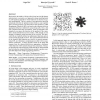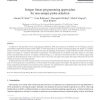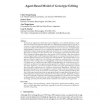799 search results - page 63 / 160 » Function Sequence Genetic Programming |
SMI
2008
IEEE
14 years 3 months ago
2008
IEEE
Motivated by the ability of living cells to form into specific shapes and structures, we present a new approach to shape modeling based on self-organizing primitives whose behavi...
BMCBI
2011
13 years 4 months ago
2011
Background: Remote homology detection is a hard computational problem. Most approaches have trained computational models by using either full protein sequences or multiple sequenc...
DAM
2007
13 years 9 months ago
2007
In addition to their prevalent use for analyzing gene expression, DNA microarrays are an efficient tool for biological, medical, and industrial applications because of their abil...
EC
2007
13 years 9 months ago
2007
Evolutionary algorithms rarely deal with ontogenetic, non-inherited alteration of genetic information because they are based on a direct genotype-phenotype mapping. In contrast, i...
EVOW
2007
Springer
14 years 3 months ago
2007
Springer
We present several practical improvements to the interactive evolution of 2D images, some of which are also applicable to more general genetic programming problems. We introduce tr...



